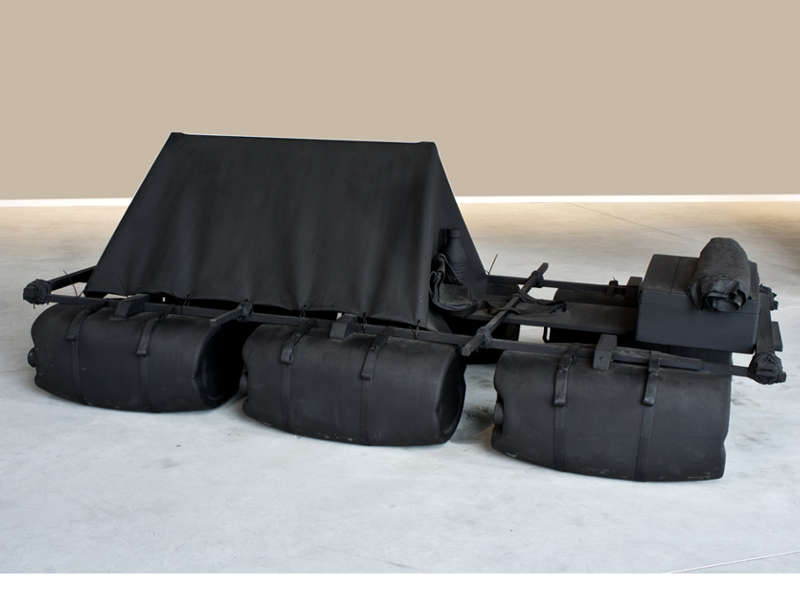
Accueil > Les rubriques > Images > The origin is the aim
The origin is the aim
Roots, history and commitment to the present : the art of Vincenzo Rusciano.
, et
Toutes les versions de cet article : [English] [italiano]
One of Vincent Rusciano’s qualities is story-telling. His works tell stories. Biographical fragments, such as the tale of a quite shy boy from the suburbs who gets in touch with the Gotha of art almost by accident. Or collective events, such as the struggle to bring to light the traces of a past that is never completely rediscovered.
Born in Naples in 1973, Rusciano is an innate sensitivity sculptor who, starting from his own life experience, has developed over the years a route in balance among the icons of childhood and the disillusionment of adulthood, the bright colors and the opacity of bitumen.
The years of education were a period of exploration, not just an introspective but also a geographical one, walking through the narrow streets of the big city looking for beauty. That period and his life in a neighborhood, Ponticelli, that he started to perceive as "hard reality" only as an adult, have influenced him in a predominant way.
As a very young boy, Rusciano collaborated with the workshops of San Gregorio Armeno to support himself while studying ; San Gregorio Armeno is the area of the city where Nativity scenes and shepherds are handmade. The stimulus provided by the handmade activity combines with the attention Rusciano always focused to the places surrounding him : so, the models, namely the metal "cores" enveloped by stuffing of tow or cotton of the shepherds, themselves become personifications of the inhabitants of Ponticelli which is a very densely populated neighborhood, where emigration and movings are everyday realities.
Each model is numbered, his figure becomes the virtual presence of someone who left, the personification of someone who has just arrived, in a sort of map of the demographic and housing development. A look at the social reality that brings, in nuce, the developing direction of the art of Rusciano.
As well as the love for the fragment, the unfinished -the "model" is a shepherd only in embryo, but aesthetically it is incomplete, as its head, hands and feet, that give it its own identity, are missing. He matured this passion primarily during the long explorations through the historic city center of Naples, where it is not uncommon to come across churches, shrines, artistic and archaeological fragments incorporated in buildings and along the streets, a city center which, as a gigantic open-air palimpsest, teaches how to evaluate and to get excited discovering a single element, to appreciate the unfinished, the imperfect, the mutilated.
Finally, the interest towards his place of origin, as a starting point and a metaphor of the social dimension, of the baggage and of the "sign" that it imprints on the ones who were born there.
Untitled (Angri - Salerno 2001) embodyes this intellectual "game" in an installation, building an ironic taxonomy of reality, a classification that, as a snapshot, provides the image of the urban dynamics with all of its contradictions, using the tradition of the eighteenth-century handcrafted shepherds.
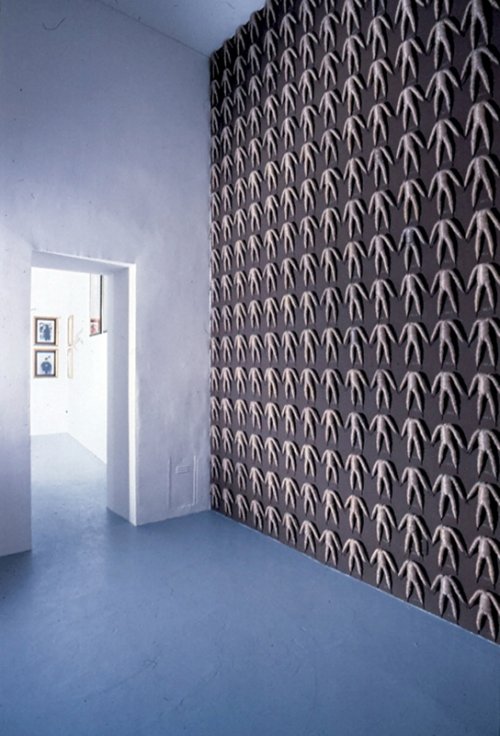
- Untitled, 2001, installazione ambientale/installation
During the years at the Art Academy, Rusciano worked as an assistant in an international, very young and experimental art gallery called Th.E. - Theoretical events (opened between 1994 and 1998), in which William Eggleston, Richard Prince, Jack Pierson, Nan Goldin, John Baldessari, Laurie Simmons and Damien Hirst exhibited their artworks.
The contact and in some cases the friendship with these artists allows him to know the world of contemporary art from a privileged point of view and to gain his own research path with a much more growing awareness. And, conversely, it allows him to anchor himself firmly to his roots.
The "imprinting" of the urban outskirts returns in artworks like Le Case del Popolo (The houses of People, 2004), an installation in which sculptural elements in the form of a house, as a result of an essential geometry, are embellished with bright lacquers and unique pedestals on which they lay (such as the richly embroidered pillow in the background of the Royal Palace of Capodimonte).
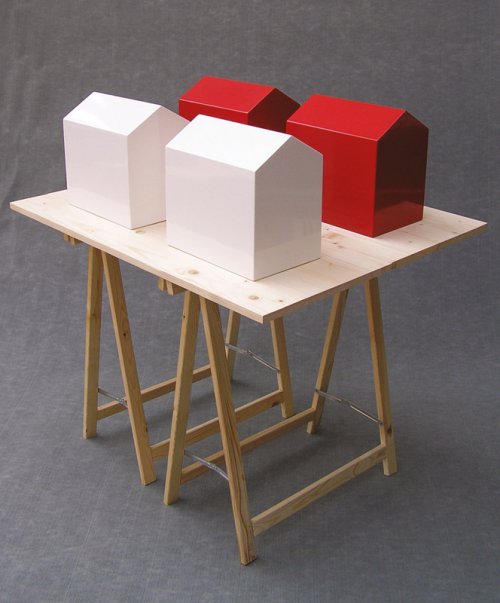
- Case del Popolo, 2004, legno laccato/lacquered wood, cm. 105X80x105x110
Le Case del Popolo (The houses of People) are similar to the social housing edifices built after the 1980 earthquake to provide accommodation to those who had lost their homes. Even if these houses were born from the desire to give a shelter, they have become early -in the collective imagination- a synonym for lawlessness and social marginalization that not necessarily represents those who live there, which are somehow "marked" only because they live there.
Rusciano’s sculptures intend to offer redemption from such an injury : their brilliance changes them into precious objects -as the home received from those who lost everything : their volume, that is impenetrable from the outside, seems to suggest that we cannot understand what happens inside.
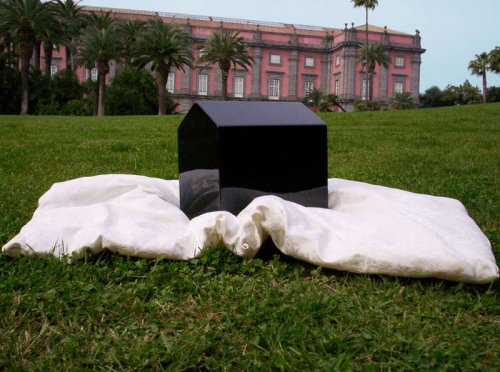
- Casa del Popolo (Single, Black), 2005, cotone, lana, dimensioni variabili/cotton, wool, variable sizes
Together with the social analysis, that is his primary interest, Rusciano celebrates the boundless freedom, generated by the imagination and developed by the star system, with Untitled (Motorbike) (Naples / Città della Pieve, 2006) which is a sculpture inspired by the model of a famous Italian modeling company, the Bburago, and by the films screened in the cinema of the district, whose posters decorate the box.
A yearning for freedom that is inextricably tied up to imaginary, to dream, to its nature of object-toy to be interpreted in a playful tone.

- Untitled (Motorbike), 2006, legno, cartone, plexiglass, metallo, stoffa, pneumatici/wood, cardboard, plexiglass, metal, cloth, tyre, cm.127x190x83
However, the game in Rusciano is never innocent. Its ambiguous appeal becomes evident in the figure of the clown, a recurring element in his mature production.
Irreverent, spiteful, in some cases defeated, but never victim, the clown represented by Rusciano is never harmless ; glazed with polyurethane paint (the same used for cars), he sneaks into the folds of everyday life with his metallic, translucent highlight.
His vitality is accompanied by the symbol of death, in a vanitas that mocks, that does not incite to reflection but to a wild life, to the depth of feeling, of touching, of living.
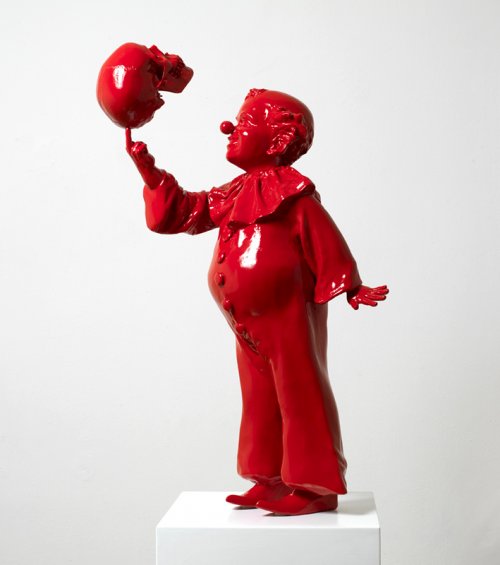
- Red Clown (Deadline), 2008, resina e vernice/resin and paint, cm.104 h
An example of that uncanny1 which at the beginning of the twentieth century gave the title to a famous essay by Sigmund Freud and which indicates the ambiguity of everyday life, the disturbing aspects of what is familiar to us, and for this reason is even more fearful .
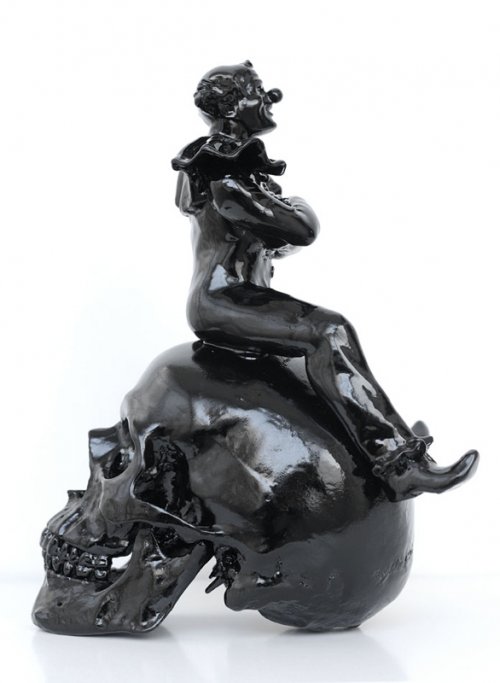
- Untitled (Black Clown, seated), 2008, terracotta, resina, vernice/terracotta, resin, paint cm. 30x18x24
In the same way, Untitled (Black Clown, seated) a mocking and priapic clown sitting on a skull and provocatively turned to the opposite direction of its empty eye sockets gaze : it is a symbol of sex, of vitality, of the panic dimension of the existence, and yet at the same time it becomes disturbing and ambiguous in its theatrical posture, in the malicious grimace he addresses to the inevitable fate.
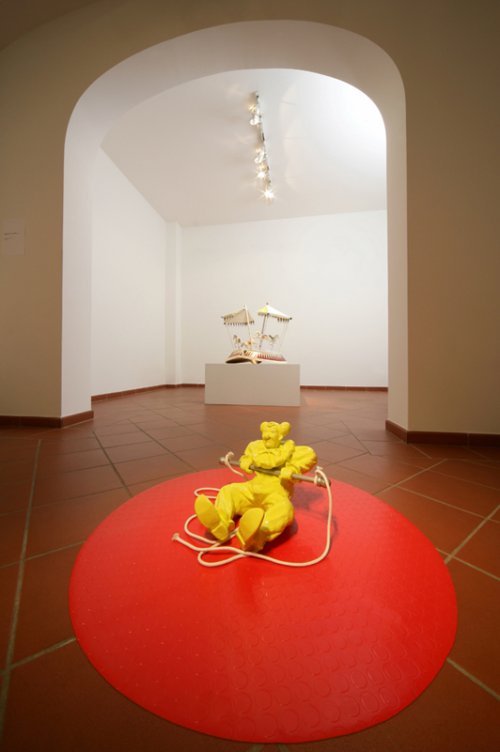
- Untitled (Yellow Clown), 2007, terracotta, legno, vernice/terracotta, wood, paint
This sculpture stands as a fundamental element of Quattro artisti e un editore (Four artists and a publisher ; Naples 2012), an exhibition organized for the celebration of the forty years of business of the Neapolitan publisher Tullio Pironti. He is a peculiar figure, almost a symbol of the contradictions of Naples : as a descendant of the Pironti’s which were already publishers during the Bourbon period, Tullio has always dedicated to publishing, but he is also known to be a boxer and a tombeur de femme. In his autobiographical book Il Paradiso al primo piano (Paradise on the first floor) he tells of his love affair with a prostitute at the time of the "case chiuse2".
For his forty years of business, Pironti invited four artists to exhibit in the office of the publishing house. Rusciano is between them and, in addition to the clown, he realizes some installations that tell each aspect of the publisher, as a puzzle that makes the image visible only when all the pieces are put together.
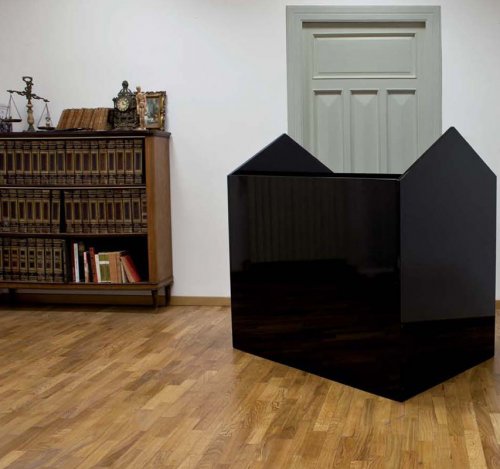
- Il paradiso al primo piano (Paradise at the first floor), 2012, installazione/Installation
The brothel of Pironti’s youth that was "closed" becomes "open" : Rusciano eliminates privacy, inviolability. Glossy black covered, almost repulsing and funeral for the commercialization of the female body that took place inside, the house was unroofed : the ceiling can no longer hide the inside, the view gives back dignity to an old fashioned love story, which was born in the shade of values fallen into decline.

- Ring, 2014, resina e grafite/resin and graphite
The Ring, which the artist takes on not only as a link to the boxer-editor, but also as a metaphor for the ongoing struggle for life. A struggle that engages all living beings, but that assumes different connotations in a city like Naples – the “paradise inhabited by devils” according to the interpretation of Benedetto Croce- and becomes a symbol of the everyday difficulties, of a hard battle with the unique aspects of the city : undisciplined, chaotic, capable of innate impulses of solidarity, but also infinitely cruel, despotic and lawless.
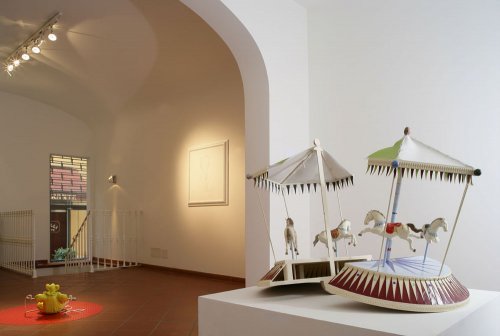
- Untitled (Merry go Round #3), 2007, legno, pelle, terracotta, vetro, swarovski, acrilico, vernice/wood, leather, terracotta, glass, swarovski, acrylic, paint, cm. 90x85
In contrast, its vital, insolent and Bacchic energy seems to inspire Untitled (Merry go Round # 3) (2007).
As a playful symbol broken by a clean cut, the carousel has only the appearance of a toy. The run of its perpetual motion, seemingly immutable, is almost the original sin of a life which development seems to be predetermined, from the moment –and the place- in which one is born.
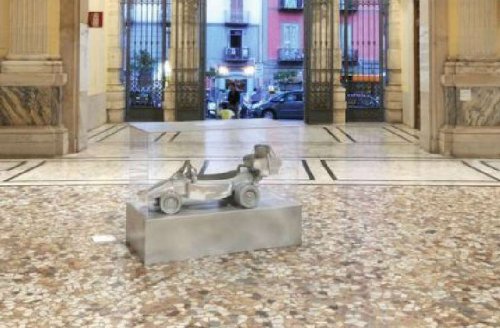
- untitled #F1, 2008, MDF, plexiglass, plastica e vernice/plexiglass, plastic, paint, cm. 100x160x80
An influence which prevents the achievement of the individual, demeans his/her talent and the opportunities for personal development. The heavy baggage, that everyone brings with him from the birth, blocks to the ground Untitled #F1, the reproduction of a Ferrari presented for the exhibition Sistema Binario (Binary System – Naples/Belgrade 2008).
The race car, which is a symbol of speed and freedom, is convicted to immobility also by the anti-lock of the anti-theft device that blocks the wheel. The power hidden in the car remains unexpressed.
Stuck in a role, in a routine that prevents any deviation, the humanity according to Rusciano reminds the prisoners of Plato’s cave. And, in order to free them you need to stop the carousel, its frenzy movement, and to open the lock : you need to be aware of that innate and involuntary baggage to break the chains of an invisible and therefore much more dangerous constraint.
Along with the desire of redemption for the individual, who is forced into the social cage that is imposed to him, time comes powerfully into the artworks by Rusciano, as history and cultural roots.
His Untitled (Vases), inspired by the restoration of Sant’Aniello a Caponapoli church3 that lasted several years, are evidences of an impossible archeology.
On their surface, elements of the artist’s personal memory and collective’s one appear : on the one hand clowns, vintage dolls, antique Roman ships, tools and equipment for the restoration of stone materials, painted in acrylic ; on the other a view of the interior of the church as it looked like before the restoration, with the wounds of the earthquake of 1980 and the monumental marble altarpiece by Girolamo Santacroce (1512-1517).
An individual and historical tale bounded to the artist’s expressive universe and to the events of the church, to its restoration site and to the long development which gave it back to the city. In the meantime the celebration of the finding of the artifacts that were stolen from, as some pieces of the altar of Santacroce, a rare example of Renaissance altar even if it was remodeled in the Eighteenth Century.
An apparently impossible rescue, as that laid down in Zattera (Raft, Naples, 2014) : on board, the archaeological fragments, as a symbol of history and memory, and the baggage of the artist, his "tools of the trade" the identity itself of art, restoration, sculpture.
The unusual orange, color recalling rescue, covers every single piece of the raft, as if the emergency would spread in all aspects of culture and existence, highlighting the urgent need for a change, for the search for a new path.
Shelter is sought, but at the same time denied by Escape, (Faiano - Salerno, 2011), a pitched-black, solitary raft, equipped for an impossible journey : the weight and the bitumen effectively impede the makeshift boat sails to a hypothetical escape ... that the artist, however, does not want to reach.

- Escape, 2011, legno, plastica, corda, tela, bitume/wood, plastic, rope, canvas, bitumen, cm. 90x130x252
Life and death, closely interconnected in Naples more than elsewhere4, the grotesque and sometimes dramatic dimension of its daily life, even the alienation of its suburbs does not discourage him. Because Rusciano was born on that ring that so many times comes back in his production.
The memory, the history, the art he has breathed and known are his talisman. No raft, no refuge can be sought far : the only salvation is the fight that everyone must take to improve the places he/she belongs to, because the choose to live every day in a city where is not easy to live, among one’s nearest and dearest, experiences, history and memory means, especially for those who make art, to deal with everyday life with the awareness of all the difficulties, but also with the presumption and the belief that you can improve it.
Voir en ligne : The website of Vincenzo Rusciano
Notes :
1 Already defined by the German psychiatrist Ernst Jensch as an intellectual uncertainty generated by a situation or an object that has familiar and strangers connotations at the same time, the uncanny becomes the subject of the essay of the same name (Das Unheimliche ) published by Freud in 1919. Both psychiatrists took the tales of E. T. A. Hoffman as samples, in particular the Sandman.
2 Or brothels (In Italian known literally as “closed houses”), whose existence has been legal in Italy until 1958.
3 The church, dating from the ninth century AD, stands on the highest point of the greek-roman Naples, where the buildings and temples of the Acropolis were. Some remains of the walls, dating from the third century BC, have been brought to light near it. Following the bombing of the Second World War, the church was abandoned and was victim of theft and vandalism. A restoration begun in 2000 and ended in 2014 with the reconstruction of the main altar, a masterpiece by Girolamo Santacroce (1517-1520), according to the structure received in the eighteenth century.
See http://www.beniculturali.it/mibac/export/MiBAC/sito-MiBAC/Contenuti/MibacUnif/Eventi/visualizza_asset.html_1600205601.html
and http://www.beniculturali.it/mibac/export/MiBAC/sito-MiBAC/Contenuti/MibacUnif/Eventi/visualizza_asset.html_1343474488.html
4 As it is demonstrated by the singular piety and the cult for the dead widespread in the city, by the many underground churches dedicated to the souls in purgatory, and even by an ossuary, the Cimitero delle fontanelle (lit. Cemetery of the little fountains), in which popular devotion "adopted" some skulls abandoned there.
Aknowledgments :
Antonella Opera for supervision of English translation

